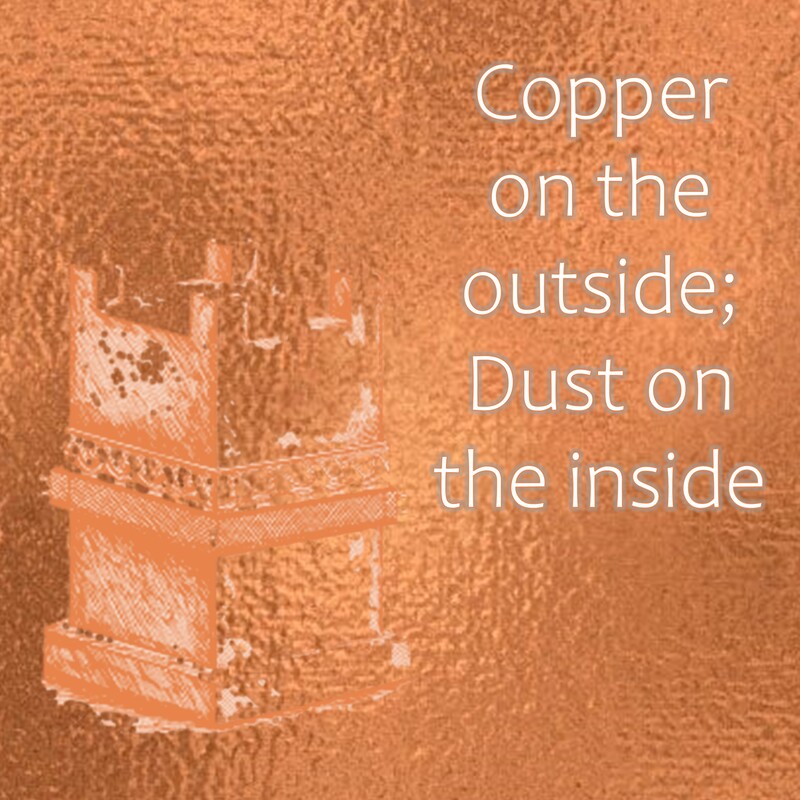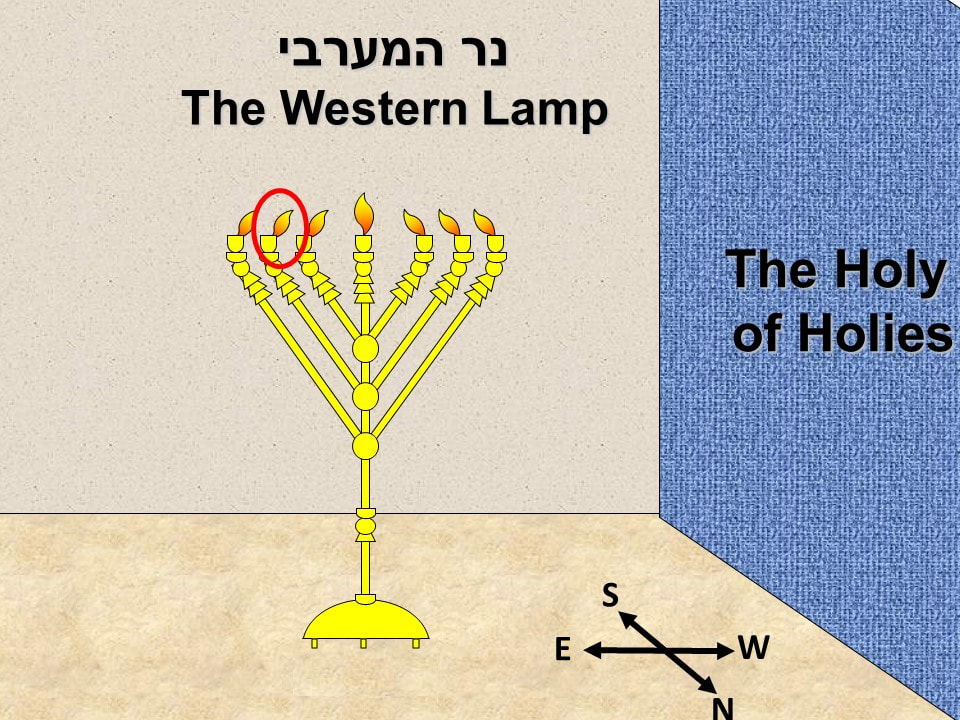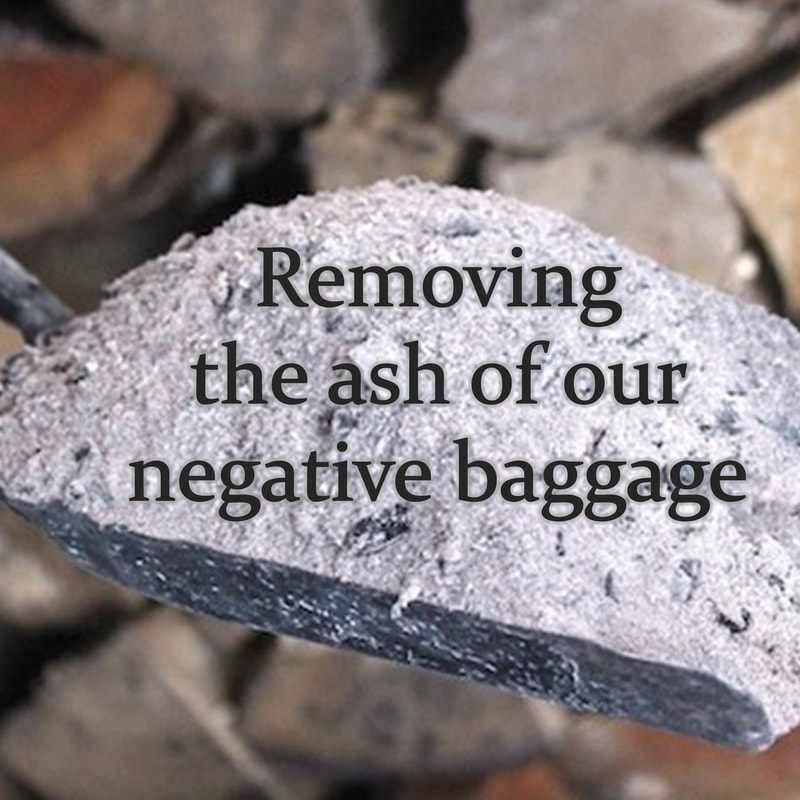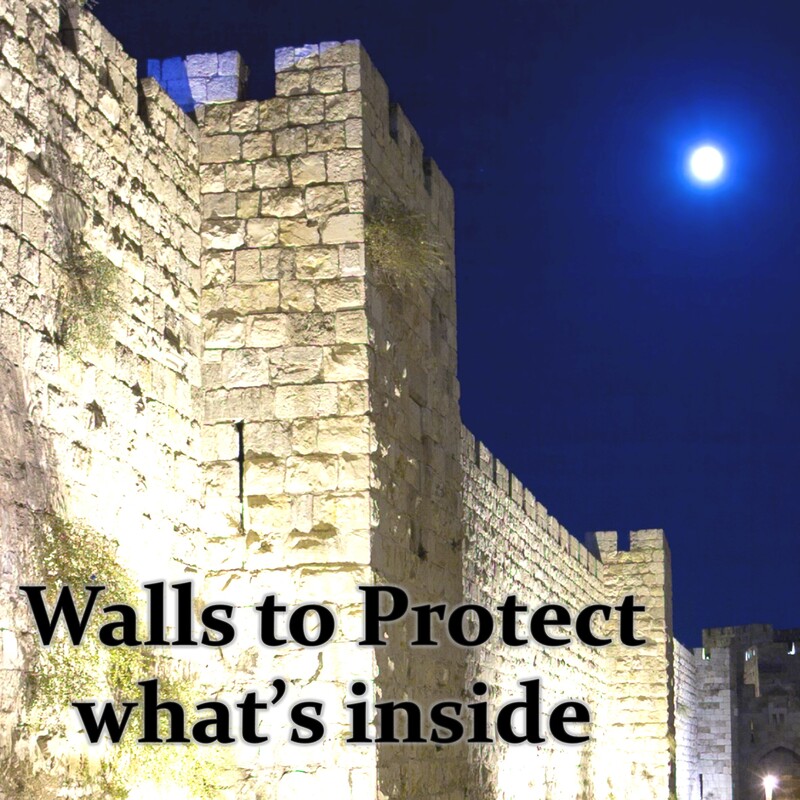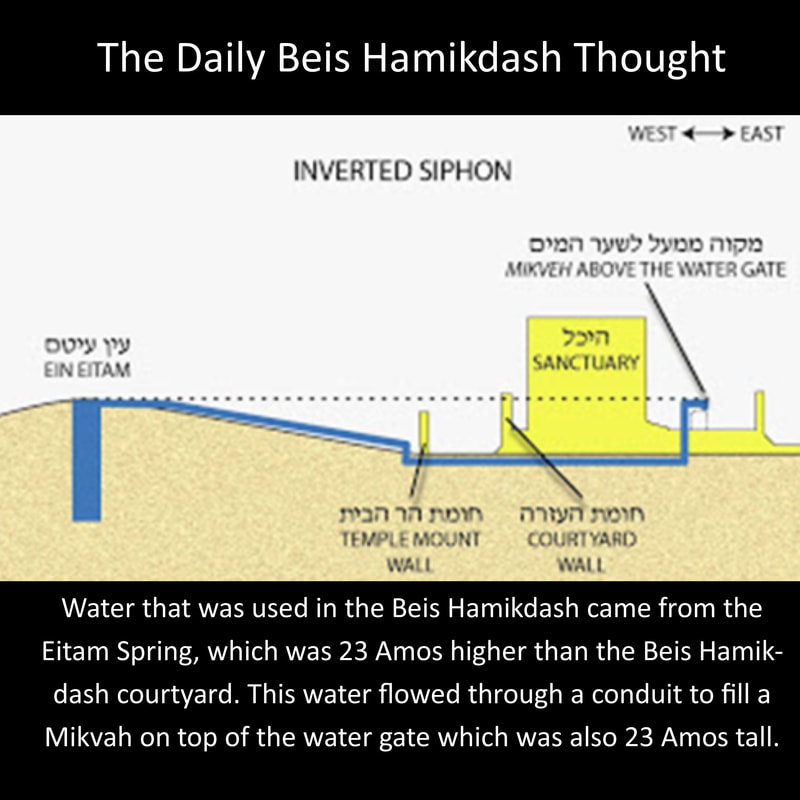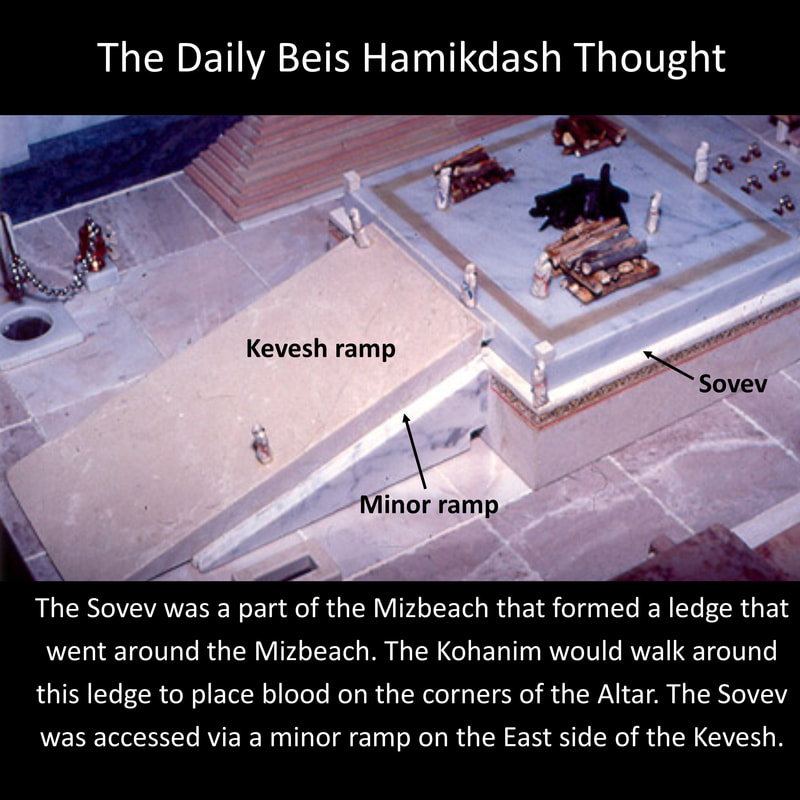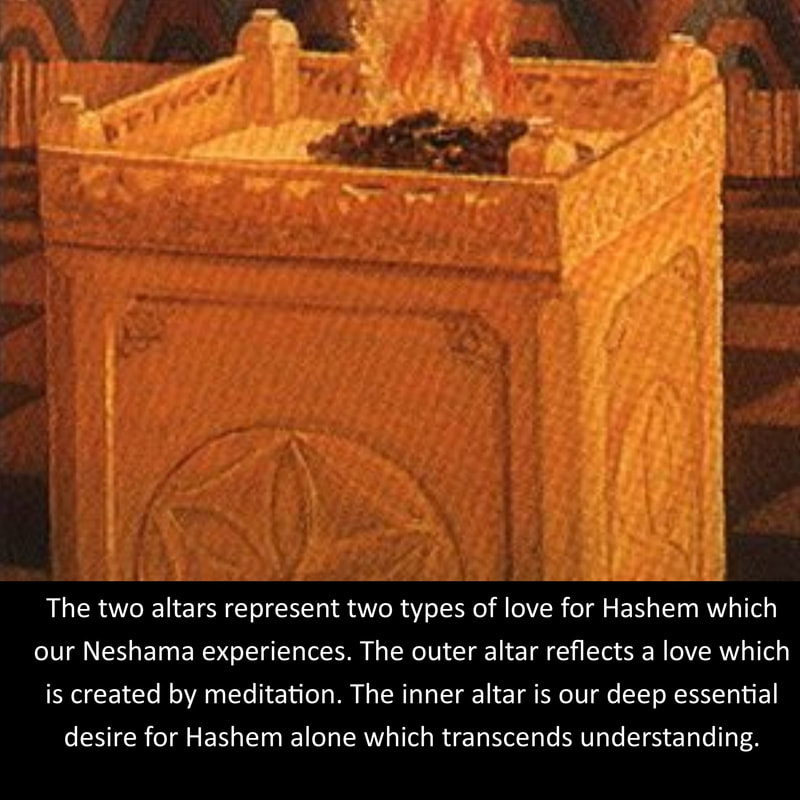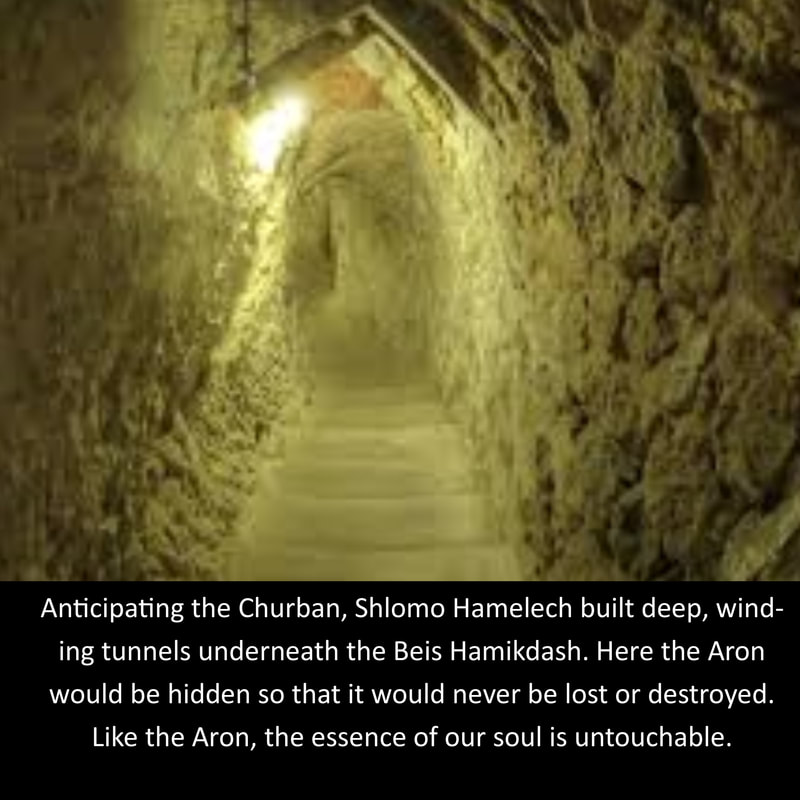|
One of the steps in the order of the morning Tamid was Hatavas Haneiros. According to the Rambam, this refers to the lighting of the Menorah. Other authorities maintain that the Menorah was only lit in the afternoon. The Hatavas Haneiros in the morning was the cleaning and preparing of the Menorah with new wicks and oil to be lit in the evening.
When the Menorah was prepared or kindled, not all seven lamps were done at once. The Kohen who was tasked with preparing or lighting the Menorah would do five of the lights. A different Avodah would be performed and then the Kohen would complete the remaining two candles. According to the sages, the Avodah that made the separation was the offering of the Ketores. In Chassidus, Ketores represents the essence of the soul and its desire for and oneness with Hashem. With this desire, the Neshama seeks to transcend the world and cleave to Hashem. The Menorah reflects the conscious levels of the soul, which are very much within the world. The seven branches represent the seven Middos, the emotions of the soul. These emotions are divided into two groups; the first five Middos are the primary emotions of the Neshama for its own Avodah. The final two, Yesod and Malchus refer to the soul’s ability to interact with and influence the world around it. The ultimate objective is that the experience of oneness (the Ketores) not remain detached from the world and isolated in moments of spiritual upliftment. We need to permeate our conscious day-to-day living (the Menorah) with the absolute awareness, connection and surrender to Hashem of the soul’s essence; not only in the holy activities of our lives (the five Middos) but also in our day-to-day worldly involvements as well (the final two Middos).
0 Comments
The sheep for the Tamid offering would be Shechted in the northern side of the Azarah. A Kohen had to collect its blood in a sanctified vessel and carry it to the Mizbeach. The blood would be applied to the north-east and south-west corners of the Mizbeach and the remaining blood would be poured on the base.
On a personal level, sacrifices represent the refining and elevating of our animalistic side, which is the source of our selfish drives, negative emotions and the pursuit of physical gratification. The lifeforce (Nefesh) of the animal is its blood - כי הדם הוא הנפש. In addition to meaning soul, Nefesh can also mean desire. The boiling blood represents the Animalistic soul’s passionate desires for materialism. The Animalistic soul itself is not intrinsically bad. Its strong desires can be harnessed and redirected in a positive way towards G-dliness. Through this we fulfil the directive of the Shema as explained by the sages, to love Hashem with both of our inclinations. Draining the blood from the animal represents removing our passion and excitement from its expression in selfish, material desires. Pouring the blood on the Mizbeach teaches us that our passionate desire and enthusiasm can and should be channelled towards the service of Hashem. In the Midrash, the sages debate which verse encapsulates the essence of the Torah. Ben Zoma teaches that it is the verse _Shema Yisrael_, which proclaims Hashem as King and declares His oneness. Ben Nanas (and elsewhere Rabbi Akiva) teach that it is the verse ואהבת לרעך כמוך – to love your fellow as yourself.
Rabbi Shimon ben Pazi says that it is the verse את הכבש האחד תעשה בבוקר “the first lamb you shall sacrifice in the morning and the second lamb you shall sacrifice in the evening.” The Midrash concludes that Rabbi Ploni said that the Halacha accords with ben Pazi. Seemingly, the verses of _Shema Yisrael_ and _Veahavta_ embody beliefs which are more central. Why does the Midrash consider a verse discussing the daily Temple sacrifices to be more fundamental? The Mahara”l explains that the uniqueness of this verse is that it expresses the idea of consistency in the service of Hashem, like a dedicated and faithful servant This is why the daily sacrifice was called the Tamid, meaning constant – an offering in the morning and an offering in the evening, day-in, day-out without change. Whether it was Shabbos, Yomim Tovim, Yom Kippur or a regular weekday, the Tamid was brought without fail. The glue that builds solid relationships is not the moments of ecstasy and passion. Rather it is the small daily expressions of loyalty and dependability done with consistency. The same is true in our relationship with Hashem. The message of the Tamid is that above all, Hashem wants our simple, consistent, daily acts, performed with discipline and dedication, which communicate “I am always thinking of You”. In the next stage of the Avodah, the Kohanim would arrange the pyres on top of the Mizbeach, including the large pyre for the sacrifices and the smaller pyre for the incense. In addition, 2 blocks of wood would be placed on the main fire each morning, referred to as the Shnei Gizrei Eitzim.
Our sages tell us that fireball would fall from Heaven onto the altar to consume the Korbanos. Nonetheless, it was still a Mitzvah to place wood on the Mizbeach each day, to fuel the fire in a natural way, through earthly, human effort. The same is true in maintaining the love that the Neshama has for Hashem. Love is like a fire. The flames of passion burn with intensity. But if not maintained, the flames eventually die down and the fire will go out. Our relationship with Hashem has ‘fireball’ moments. We become inspired on the Yomim Tovim and Yomim Noraim. We may experience a personal awakening from Above where we feel connected and Hashem draws us close, through little or no effort of our own. This love comes to us as a gift from Heaven. But to keep our love burning, we can’t rely only on these fireball moments to do the trick. Hashem wants us to feeding the fire on a daily basis through our own earthly efforts. We do this in study and prayer, by using our own minds and hearts to meditate on Hashem’s greatness and try to connect to Him and sense His presence. The earthly fire, fuelled by the wood each day was the magnet that elicited the fireball from Heaven. When we try to cultivate and develop our love for Hashem through our own efforts, the fire from below, Hashem will respond with a powerful revelation of His presence within our lives with His fire from above. Before removing the excess ashes from the Mizbeach and taking them outside of the camp, the Torah teaches “he shall remove his garments and put on other garments”. The Kohen would have to change his clothing, to prevent his Priestly robes becoming soiled.
Even though the removal of the ashes was also a necessary part of the Temple service, it could not be compared to the actual Avodah that was performed inside the Beis Hamikdash. To highlight this, a more inferior set of clothing was worn for removing the ashes. Rashi illustrates this with a parable; the clothing worn by a servant when cooking for their master, should not be worn when pouring the master’s drink. Cooking the meal is a necessary preparation to be able to serve the meal, but the cooking is merely a means to reach the ultimate objective, to serve the meal and honour one’s master with it. The removal of the ashes was a necessary preparation, to create space to serve Hashem with the new offerings. In yesterday’s post, we explained that the removal of the ashes represents our inner work to confront and remove our negative issues and baggage. Our sages teach that a person should only start to pray having experienced a sense of contrition. But this should only be a preparation to make space for a deeper emotional experience. Once we start the Avodah of davening itself, we must push away this sense of contrition and daven from a place of true joy and love. Like the Kohen removing the ashes, we don’t want our dealing with negative baggage to sully us, so we must ‘put on other garments’. But after we’ve removed our ashes, we divest ourselves of these ‘garments’, pushing away all association with the negative, to honour our Master with the fresh, clean garments of joy and positivity. The first Avodah that was done each day in the Beis Hamikdash was Terumas Hadeshen.
One of the Kohanim, selected by a lottery, would go up onto the Mizbeach and take a panful of ashes. He would bring the ashes down the ramp and place them on the side of the Mizbeach, where it would become absorbed on the floor of the courtyard. In addition to the Terumas Hadeshen, the Kohanim would remove the excess ashes from on top of the Mizbeach. These ashes would be taken to a designated place outside of the camp. The ashes are the residual that remains after the Korbanos have been burned. The choice parts of the Korban would burn and ascend on High. The ashes that remain are the Pesoles, the ‘waste’ that remains below. There are two types of Pesoles. One type cannot be elevated and we must distance it completely and remove it from our camp. The other type of Pesoles has some good quality in it that can be refined, elevated and incorporated into the side of Holiness. In Avodah, these two types of Pesoles are Merirus and Atzvus; bitterness and depression. One has to serve Hashem with joy. Therefore, both Merirus and Atzvus, being negative emotions, are considered as Pesoles; undesirable states of mind. But there is a difference between them. Merirus is feeling bad about one’s self and spiritual standing in a way that leads to resolve to change and active steps to grow. There is a positive element within Merirus that ultimately leads a person back to Simcha. Atzvus – depression, is an overwhelming feeling of lowness that leads to despondency and giving up. Merirus, like the ashes placed by the side of the Mizbeach that remain within the Azarah, can be elevated and used as a tool in our service of Hashem. Atzvus, like the ashes that were taken out of the camp, must be removed entirely from our experience. ~ Based on Maamarim Kuntreisim volume 1 page 545 When the Beis Hamikdash stood, the central focus of the service of Hashem revolved around the sacrifices that were offered by the Kohanim.
Even though the Temple no longer stands, it does not mean that we no longer have the Avodah of Korbanos. Our sages teach that whoever occupies themselves in the Torah-study of the sacrifices, it is considered as though they have offered those sacrifices. And our daily prayers were enacted in place of the Korbanos. In our morning Davening, as we read the description of the daily Tamid offering, we quote the Posuk ונשלמה פרים שפתינו “We will repay the bulls (of the sacrifices) with our lips”, alluding to how our words of prayer are in place of the sacrifices. The word ונשלמה can also mean to complete. This suggests that there is an advantage in our prayers and Torah study about the Korbanos, which completes a deficiency in the actual Korbanos. The physical observance of the sacrifices was limited - in time, place and soul. They could only be performed in the Beis Hamikdash, at specific times and by the Kohanim alone. But the study of Torah transcends all of these limitations. Every Mitzvah is eternal. Those Mitzvos that we can no longer observe physically, can be observed spiritually, through the inner lessons that they teach us. Over the next 3 weeks, we will be exploring the inner lessons from the various elements of the daily order of the sacrifices. May our learning about the Avodah of the Beis Hamikdash and applying these lessons to our daily lives be considered as though we have offered Korbanos to Hashem. And may this hasten the restoration of the Beis Hamikdash and the daily Avodah once more. The sacrificial altar in the Mishkan was very different to the Mizbeach in the Beis Hamikdash.
In the desert, the Mizbeach was constructed as a hollow shell built out of acacia wood. The wood was covered with copper-plate. The Torah says that the Mizbeach had to be made as a מזבח אדמה, an altar made of earth[1]. How did the Mizbeach in the Mishkan meet this criterion? At each place that Bnei Yisroel camped the hollow of the Mizbeach would be filled with earth[2]. So, the Mizbeach had dust on the inside and copper on the outside. In one of the prophesies of Yishayahu[3], Hashem says about the Jewish peopleמדעתי כי קשה אתה וגיד ברזל ערפך ומצחך נחושה – “I know how stubborn you are, that your neck is like an iron sinew and your forehead is like copper”. A copper forehead is a metaphor for brazenness – ones holds their head up strong and does not show shame or humility. Rashi explains that the Mizbeach was covered in copper to atone for the sin of brazenness. But like all Middos, the Middah of brazenness can also be used in a holy sense. It represents being strong in one’s service of Hashem and to not be embarrassed from those who mock at us[4]. Like the copper coating this brazenness should only be an outward and external show. On the inside, we need to be filled with earth, reflective of humility, as we say in our daily Shemoneh Esrei “let my soul be like dust before all”. ~ Based on Reshimos booklet 108 When the Kohen entered the Kodesh to clean the Menorah in the morning, he would find the 2 eastern lamps still alight[1]. They would be left to burn throughout the day. In the evening all 7 lamps would be lit and would burn through the night.
In our previous post, we explained that 7 branches of the Menorah represent the 7 emotional drives of the soul, which parallel the 7 Divine energies of the Sefiros. In Tehillim[2], Hashem’s presence is likened to the sun. Daytime represents a state where Hashem’s presence is openly revealed. We experience illumination and the physicality of the world does not create any concealment. Night represents spiritual darkness, when we do not perceive G-dliness. We grope around in confusion and we suffer the challenges presented by the material world. To remain strong in a night-time state, we need the light of all 7 candles – to actively engage with and illuminate each aspect of our soul. For example, it is not enough to just fulfil the Mitzvos with love (Chessed). One also needs to have a feeling of awe (Gevurah) to keep them from sin. The same is true for each of the 7 Middos. When we experience spiritual daytime, the light of the 6th candle suffices. Because Hashem’s presence is revealed, all we need is to reveal Yesod - our deep connection to Hashem. This connection will be enough to influence all of the other dimensions of our psyche. But the prerequisite to attaining Yesod is Malchus - humility and surrender to Hashem. And so, when the sun of Hashem shines in our lives, these 2 candles are all that we need. ~ Based on Reshimas Hamenorah, Torah Or 29a The Talmud teaches that Hashem did not ‘need’ the light of the Menorah. Rather, the light of the Menorah served as a testimony to the entire world that Hashem’s presence rests amongst the Jewish people.
More specifically, the testimony was the miraculous ‘western lamp’ (נר מערבי). The other candles of the Menorah only burned through the night. Even though the ‘western lamp’ contained the same amount of oil, it would burn through the day as well. The Kohen would use it to light the other candles that evening. According to the view that the Menorah stood facing from east to west, it would seem that the ‘western lamp’ refers to the western-most lamp; the one closest to the Holy of Holies. However, the commentaries explain that the ‘western lamp’ was actually the 2nd lamp from the East. It is called the ‘western lamp’ because it was the first lamp towards the West. The 7 branches of the Menorah represent the 7 emotional drives of the soul, which parallel the 7 Divine energies of the Sefiros. These give rise to 7 different ways in which we serve Hashem; love (Chessed), discipline (Gevurah) etc. The western-most flame corresponds to the first Sefira - Chessed (love and kindness). The 6th candle corresponds to the attribute of Yesod and the 7th candle corresponds to the attribute of Malchus. Yesod is Hiskashrus – a deep bonding and intimate connection with Hashem. Malchus is humility. So, the unique ‘western lamp’ is Yesod. It is used to light the others because Yesod – a deep intimate connection with Hashem – is the source that ignites and leads to all of the other specific modes of serving Hashem. The Torah describes this lamp as being ‘before Hashem’ (the Divine presence that rested in the Holy of Holies which was to the West). This is because the intimate connection of Yesod places us face-to-face before Hashem. But the 6th lamp is only the ‘western lamp’ because it sits to the west of the 7th flame. Whilst the primary aspect of serving Hashem is our Hiskashrus, one cannot attain this deep connection (Yesod) without first having humility (Malchus). ~ Based on Reshimas Hamenorah and Igros Kodesh Volume 3 p229 The first Avodah that was done in the Beis Hamikdash each day was Terumas Hadeshen. This was done before any sacrifices could be brought.
The Kohen designated by a lottery, would go up onto the Mizbeach and take a panful of ashes. He would bring the ashes down the ramp and place them on the side of the Mizbeach. These ashes would miraculously be absorbed by the floor of the Azarah. In addition to the Terumas Hadeshen, the Kohanim would remove the excess ashes from the Mizbeach and take them to a designated place outside of the camp. The sacrifices represent our spiritual growth and personal Avodah. But before we can engage in meaningful positive growth, we need to remove and deal with our negative baggage – our ashes. If we don’t, they will hold us back and create a blockage to achieving the growth that we seek. The ashes placed beside the Mizbeach represents the negative baggage that we can deal with, overcome and transform. But there may be things that we presently don’t have the ability or strength to deal with. Instead of letting them linger, we need to move them outside; to put them completely out of our mind and out of our experience, so that they too will not pull us down. They should remain outside until we have the strength to face them. ~ Based on Maamar Parshas Reeh 5714 The primary function of walls is to provide protection for those within them. The walls afford this protection in two ways;
Even when the enemy forces are camped outside of the city, making noise and threats, the wall creates a barrier that prevents them from being able to enter and do any real harm. Behind the protection of the walls, the defending soldiers are able to consolidate and build their strength, so that they can drive away the enemy completely. Our G-dly soul and animalistic soul are in conflict. The G-dly soul is enclothed within the animalistic soul. Our animalistic side seeks to dominate our G-dly soul, leading us to sin and pursuit of worldly desires. The G-dly soul wants to express its light and subjugate the animalistic soul in the service of Hashem. Our G-dly soul, like the Beis Hamikdash, is a place of incredible holiness. But we need walls to protect our G-dly side from the attacks of our animalistic soul which seeks to bring us down. This protection is also twofold; Even when our animalistic soul ‘makes noise’ with thoughts of sin and negative emotions, the wall is the protection that prevents it from getting in and actualising these impulses in thought, speech and action of sin. The protection of the wall also allows us to consolidate and strengthen our G-dly soul, so that we have the spiritual strength to overcome and transform our animalistic side completely. Our sages teach חומה זו תורה – the wall of spiritual protection is the study of Torah ~ Based on Sefer Maamarim 5693 p508 The Beis Hamikdash was surrounded by a series of walls. There were walls around the Azarah (courtyard) and there were walls around Har Habayis (the Temple Mount).
Walls create a protective barrier of defence to keep out any enemies or undesirable forces. But they also serve another function; Walls delineate how far the borders of a city extend. The different areas within the Beis Hamikdash compound had differing degrees of holiness, reflected in what Avodah could be done in each area. These areas were delineated by borders in the form of the walls. The holiness of the inner space extended until the wall. In Avodah we also need walls around our ‘holiness’. Our G-dly passion needs to be contained so that it does not manifest in the wrong place or the wrong way. Unrestricted, our inner spiritual intentions could result in the opposite of what we are trying to achieve. To share 2 couple of examples; Before engaging in Avodah, a person should introspect on their spiritual standing so that feel a sense of humility before Hashem. Without ‘walls,’ the Yetzer Hara can hijack this introspection to bring a person to feeling of depression and melancholy. These feelings lead to a sense of inadequacy and apathy, where we feel incapable and unworthy of serving Hashem. Another example is the condition described in Chassidus where a person’s fiery passion in davening and Avodah can lead to feelings of fiery anger and indignation towards others, once the davening is over. Without protective boundaries, the holy emotions can spill over into unholy manifestations. We need limits to confine our holiness, ensuring that it is expressed only in a positive way and that it doesn’t express itself where it doesn't belong. ~ Based on Sefer Maamarim 5693 p508 The water used in the Temple was sourced from the nearby spring, Ein Eitam. Our sages identify Ein Eitam as being the highest point in Eretz Yisrael.
One of the Mikvaos in the Beis Hamikdash was built on top of the Water Gate. This Mikvah was used by the Kohen Gadol on Yom Kippur for his first of 5 immersions. The Temple gates were 20 Amos (approximately 10 metres) high. The measurements of a Mikvah are (minimum) 1 by 1 Amah with a depth of 3 Amos. Therefore, the water level in this Mikvah would have been 23 Amos above the courtyard floor. The water would flow down from Ein Eitam towards the Beis Hamikdash and then brought up with an inverted siphon effect to fill this Mikvah. Due to natural pressure, water in an inverted siphon will always find a level. Since this level cannot be higher than the original source of the water, our sages deduce that the Eitam spring must also have been 23 Amos above the courtyard level. If you want to raise water to a level higher than its source, an outside force, such as a pump, is required. The Neshama, like water flowing downhill, descends from its lofty spiritual source into a body down here in the physical world. This descent is for the purpose of achieving an even greater elevation. But without any outside force, the Neshama cannot rise higher than the source from which it came. Torah and Mitzvos act like a pump. When the Neshama keeps Torah and Mitzvos in this world and engages in refining the body and animalistic soul, it reaches levels of connection to Hashem which are far deeper than the Neshama would have otherwise experienced. This powerful G-dly force pumps the Neshama up to the highest of heights. The Torah commands us that “a perpetual fire should burn on the Mizbeach and never be extinguished”. The Torah gives us the responsibility to maintain the altar’s fires. And so, in the Holy Temple, two blocks of wood had to be placed onto the altar each day to fuel its fire. The wood for the Mizbeach would be stored in a special-purpose store room in the Ezras Nashim.
Our sages tell us that fireball would fall from Heaven onto the altar to consume the Korbanos. Nonetheless, it was still a Mitzvah to place wood on the Mizbeach each day to fuel the fire in a natural way, through earthly, human effort. The same is true in maintaining the love that the Neshama has for Hashem. Love is like a fire. The flames of passion burn with intensity. But if not maintained, the flames die down and the fire will go out. Our relationship with Hashem has ‘fireball’ moments. We become inspired on the Yomim Tovim and Yomim Noraim. We may experience a personal awakening from Above where we feel connected and Hashem draws us close, through little or no effort of our own. This love comes to us as a gift from Heaven. But to keep our love burning, we can’t rely only on these fireball moments to do the trick. Hashem wants us to feeding the fire on a daily basis through our own earthly efforts. We do this in study and prayer, by using our own minds and hearts to meditate on Hashem’s greatness and try to connect to Him and sense His presence. The earthly fire, fuelled by the wood each day was the magnet that elicited the fireball from Heaven. When we try to cultivate and develop our love for Hashem through our own efforts, the fire from below, Hashem will respond with a powerful revelation of His presence within our lives with His fire from above. The Torah teaches “you shall not ascend my Mizbeach with steps (מעלות) so that you do not reveal your nakedness upon it”. This is counted as one of the 365 prohibitions of the Torah. Instead, the Kohanim would climb the Mizbeach via a ramp (כבש).
The word for steps – מעלות – derives from the root עלה, meaning to go up. Maalos is used to describe a person’s qualities and accomplishments that elevate them to a particular level or status. The Mizbeach represents the service of Hashem. The Torah is telling us that when we begin climbing the Mizbeach of serving Hashem, we should not focus on scrutinising our Maalos – our spiritual qualities and accomplishments. The concern is that by doing this, we may come to uncover our ‘nakedness’. When we honestly reflect on our spiritual accomplishments and where we really stand, we can come to realise that we are in fact spiritually ‘naked’ and lacking; that we are lowly and not lofty. When we focus on our deficiencies, we may feel ourselves inadequate and unworthy to be able to serve Hashem or feel like a fake for trying to do so. Despite where we are up to and what is going on inside, Hashem wants our service. We can and we must climb the altar of serving Hashem. But how is it possible to advance in keeping Torah and Mitzvos when we don’t feel anything inside or if we feel spiritually low? The answer is via a Kevesh. Kevesh, meaning ramp, comes from the word to conquer. When we feel spiritually low, we need to conquer our feelings of inadequacy and ‘throw’ ourselves into the Avodah. Even if we feel like a fake, we have to find the inner strength to keep the Mitzvos, because that is what Hashem wants. This is the Middah of Kabbolas Ol. When we climb the Mizbeach with this approach, Hashem will help us, so that ultimately, we will attain true and genuine spiritual accomplishment. ~ Toras Menachem 5713 volume 2 p189 In the passage describing the building of the Mizbeach, there are 2 contradictory verses. One verse says “Make for Me an altar of earth (אדמה)”. The very next verse says “And if you make for Me an altar of stones (אבנים).”
The Midrash resolves the contradiction. The word ‘if’ in the second verse does not mean that it is optional. Building the Mizbeach out of stone is obligatory. When the Torah mentions “an altar of earth”, it is not referring to the construction material, but rather to the requirement that the Mizbeach sit directly on the ground and not be built over tunnels or columns. This obligation to build the Mizbeach out of stone only began upon entering Eretz Yisroel. The Mizbeach in the Mishkan was not made of stone. It was built as a hollow wooden structure and covered with copper-plate. When they would camp, the hollow would be filled with sand and was literally “an altar of earth”. The difference between earth and stone is that stone has greater strength and durability. In our Avodah, the Mizbeach represent davening, which is in place of the Korbanos. Davening is called the ‘service of the heart’, an experience of emotion. Chassidus explains that there are two modes of emotional connection to Hashem. One level is through the emotions that are developed through meditation. Limited by our understanding, this love is more external and weak and can therefore fade after davening is finished. A deeper level of emotional connection is through revealing the Neshama’s powerful desire for Hashem that transcends intellect and reason. This love is strong and lasting. Being in the desert represents a state of spiritual infancy when we are at the beginning of our service of Hashem and not yet able to experience the deeper connection. And so the Mizbeach of the Mishkan, which was only a temporary structure, was an “altar of earth”. Arriving in Eretz Yisroel represents a state of spiritual maturity and open G-dly revelation when we are able to experience the deeper and stronger emotional relationship with Hashem that transcends intellect. And so the Mizbeach in the Beis Hamikdash was “an altar of stone”. ~ Based on Sefer Hamaamarim 5658 ד"ה זה יתנו The Navi Zechariah was shown a vision of a golden Menorah that was very different to the Menorah of the Beis Hamikdash.
In his vision, the Menorah had a bowl on its top. Coming out of the bowl were 7 pipes that fed into the 7 candles of the Menorah. On either side of the bowl stood an olive tree and an olive press. Clusters of olives would fall from the trees into two golden presses which would crush the olives. The pure oil would flow into the bowl where it would collect. From there, it would flow through the 7 pipes to fill the 7 candles of the Menorah. All of this happened by itself without any human involvement. The Menorah in the Beis Hamikdash needed human effort at each step. The olives needed to be harvested and pressed to produce the oil. There was no bowl and no pipes to automatically feed the candles. Every day the Kohen would have to refill the Menorah with fresh oil. The difference between the 2 Menorahs reflects the difference between the experience of Geulah and during the time of Exile. The Menorah of Zechariah was a Messianic prophesy. The G-dly revelations that we will experience in the time of the Geulah are so lofty that they are beyond our capacity to elicit. Like the oil in Zechariah’s vision, these revelations will flow by themselves from above, independent of our efforts. In Kabbalah this is called an Isarusa D’leila, an awakening that comes from above. The Menorah of the Beis Hamikdash represents the pre-Geulah reality. This reality is a world of action where our efforts are imperative. During Golus, our work of refining physicality is constantly required to illuminate the world with the light of Hashem. This is referred to as an Isarusa D’lesata, an awakening elicited from below. The Menorah of the Beis Hamikdash reminds us that while we are still in Golus, now is the time for action. What we do makes all the difference. Through our efforts, we will merit to experience the Menorah of Zechariah, when Hashem will fill the world with the light of the Geulah. ~ Based on Or Hatorah Vayechi p1120 The ramp used to climb up to the top of the Mizbeach is called the Kevesh. On the Eastern side of the main ramp was a smaller ramp which went to the Sovev. The Sovev (literally to go around) was a ledge, 1 Amah wide, that went around the Mizbeach. The Sovev stood 6 Amos above ground-level.
The Kohanim would climb up to the Sovev and walk around it, to apply the blood of the Chatas offering to the 4 corners of the Mizbeach, starting at the South-Eastern corner and finishing at the South-Western corner. The Kohen would then descend from the Sovev via another minor ramp on the Western side of the Kevesh. Our sages describe this Avodah in the Mishna; עלה בכבש ופנה לסובב, “He would go up the ramp and turn to the Sovev”. We read this Mishna each day as part of the Korbanos in davening. The word Kevesh also means to conquer. Our sages teach איזהו גיבור הכובש את יצרו, “who is strong? One who conquers their evil inclination”. The ultimate Avodah is not to destroy or crush the Yetzer Hara, but rather to conquer it. Our Yetzer Hara remains present, but we strive to restrain its negative expressions and impulses and instead harness its positive qualities to use in the service of Hashem. In Kabbalah, Sovev (meaning surrounding), refers to the essential light of Hashem called the אור הסובב כל עלמין. This light is so lofty that it cannot be contained and manifest within the order of created worlds. Instead, it remains hidden and transcendent. Only a contracted ray of light (ממלא כל עלמין) filters into the worlds in the process of creation. The inner meaning of the Mishna is; עלה בכבש, through every effort and ascent that a person climbs in conquering their Yetzer, פנה לסובב, they access and draw down Hashem’s transcendent light that would otherwise be beyond the worlds. Our Yetzer Hara challenges us with negative impulse, including; anger, jealousy and unholy desires. Each time that we conquer one of these urges by not acting upon them and giving them expression, we connect ourselves to the highest levels of G-dliness and infuse them into our soul and into our world. ¬ Based on Maamarim Kuntreisim Beis ד"ה איזהו גבור The Azarah (courtyard) of the Beis Hamikdash had 7 gates. Each of these gates had gold-plated doors (with the exception of the gate of Nikanor whose doors were of copper). These doors were closed each night. Each doorway also had a curtain which would be draped across the gate during the daytime when the doors were open. The purpose of these curtains was for privacy.
There were 6 other curtains in the Beis Hamikdash, including 2 curtains separating the Kodesh and Kodesh Hakodoshim. In mystical teachings, a veil or curtain represents a restraint on intensity. Just like a curtain are used to filter light, blocking out its intensity and allowing a more tolerable level of light to enter the room, there is a need for ‘curtains’ in the spiritual sense as well. The Kabbalists explain that the G-dly radiance of the Infinite Light was too powerful to be received by a created reality. And so Hashem veiled His light through a process of Tzimtzumim, contractions, which limited the intensity of the light in order to create finite worlds and be manifest within them. The open doorways represent how the G-dly revelation that pervaded the Beis Hamikdash shone outwards. The curtains reflect how this light needed to be filtered to allow the wider-world to receive it. In our interactions with others, we also need curtains and filters. Sometimes we may be too intense and overwhelm those around us by not give them enough space or consideration. We may come across too strong in our opinions. We may be too blunt and forward, saying things without filtration. Or we may share our emotions too intensely, smothering the other with our love and closeness or pushing them away with our anger or distance. When our doors are open and we want to share our inner self with others, we need to think about the other with whom we are sharing our ideas and emotions and how we can share them in a way that will be best received. Like the Beis Hamikdash, our open doorways sometimes needs a curtain. ~ Based on Derech Mitzvosecha Mitzvas Milah “This is the making of the Menorah, hammered out of gold, from its base (יריכה) until its flower (פרחה) it is hammered out” (Bamidbar 8:4)
The golden Menorah represents the collective of the Jewish people. The Menorah had to be made from one solid block of pure gold that was hammered into shape, reflecting the unity of the Jewish people. This verse identifies two of the features of the Menorah, the base (or leg) and the decorative flower. The base represents people on a lower spiritual level. The flower represents the Tzaddikim whose service flourishes and blooms with beauty. The prophet Zechariah was shown a vision of “a Menorah made entirely of gold ”. The Midrash connects this vision to Hashem’s description of the Jewish people in Shir Hashirim "You are entirely beautiful My beloved, there is no blemish in you ”. The prophets Yechezkel and Yirmiyahu who foretold of the destruction of the Temple, castigated the Jewish people for their sins, likening them to silver, bronze and copper which have sediments and impurities. But Zechariah saw the Jewish people like the Menorah that had to be made entirely of the purest gold; a people who are all beautiful and free from any sediment or imperfection. Yechezkel and Yirmiyahu looked at the surface and saw their deficiencies. Zechariah looked deeper and saw the essential core of every Jew. This inner core is pure gold that cannot be tainted. The Menorah teaches us to see every Jew, be they a flower or a base, as a pure Neshama which fills the world with the light of Hashem . ~ Based on Likutei Torah Behalosecha ד"ה ראיתי והנה מנורה After the destruction of the first Beis Hamikdash, the Jewish people were sent into exile in Bavel. While in Bavel, Hashem instructed the prophet Yechezkel to teach them the details of the design of the Beis Hamikdash. Yechezkel challenged Hashem, “how are they capable of making the Beis Hamikdash while they are in exile? First let them leave their exile and then I will tell them!” Hashem responded, “just because My children are in exile should the construction of My home be neglected?”
Exile represents a state of spiritual lowliness, darkness and distance from Hashem. When we feel disconnected we may see ourselves as not capable or worthy of serving Hashem. How we can be involved in making this world into a home for Hashem when we are not in a good place ourselves? Hashem’s answer to Yechezkel teaches us that no matter how low you may feel, or what situation you find yourself in, Hashem wants you. Despite your darkness and struggles, you have the ability to draw Hashem into your life, to build a home for Him and actualise His desire to live within us. ******* In the continuation of this Midrash, Hashem says that by learning about the design of the Beis Hamikdash in Torah, He will consider it as though we have been involved in actually rebuilding the Beis Hamikdash. The Rebbe draws on this Midrash as the basis for learning about the Beis Hamikdash during the Three Weeks. We look forward to sharing the Daily Beis Hamikdash Thought with you. Through this study may we merit to see the Third Beis Hamikdash with the imminent arrival of Moshiach. There were two altars in the Beis Hamikdash. The Mizbeach Hachitzon, the outer altar used for the sacrifices, stood in the courtyard. Inside the Heichal was the Mizbeach Hapenimi, the inner altar which was used for offering Ketores.
The Alter Rebbe identifies two levels of emotional connection, two experiences of fiery love for Hashem. These two dimensions are represented by the two altars. The outer altar represents the emotions of the conscious soul, referred to as חיצוניות הלב, the external heart. These are the feelings of love for Hashem that are developed through meditation on Hashem’s greatness. The inner heart (פנימיות הלב), represented by the inner altar, is the essential desire which comes from the essence of the soul. This desire transcends reason and understanding. It is the implicit, powerful desire for Hashem alone that every Jew possesses. The correlation reflects itself in the Avodah of each of the two altars. Korban (sacrifice) comes from the word Karov, drawing close. The fire generated by meditation draws us close to Hashem. The fires of the outer altar, consume the desires of the animalistic soul. But we remain separate and the experience dissipates. Ketores (incense) is related to the Aramaic term for a knot. A knot binds two things together so that they become one. This is the suprarational love and desire from the essence. Once revealed, this love never passes. Sources Tanya Igeres Hakodesh chapter 4 Likkutei Torah Sukkos, Ushavtem Mayim Hemshech Ayin Beis chapter 212 Anticipating the destruction of the Beis Hamikdash, Shlomo Hamelech built winding passageways deep under the Temple floor. Here the Aron would be hidden so that it would never be destroyed or taken captive.
The Aron was absent from the Kodesh Hakodashim in the second Beis Hamikdash, but its presence and influence was there from deep below the surface. Unlike the rest of the Beis Hamikdash which was completely destroyed and the other Keilim which were plundered, the Aron was untouched by the destruction. Inside the Aron were the Luchos, with the words of the Aseres Hadibros carved into stone. Unlike written letters, where the ink and paper are ultimately separate, carved letters are one with the stone into which they are cut. The Aron represents the essence of the Neshama. At the outer levels of our soul, we become connected to Hashem like ink on paper through the Mitzvos that we do, through our feelings and meditation. At our essential core, like the letters on the Luchos, we and Hashem are one. The destructive forces of our animalistic soul may attack our inner Beis Hamikdash, eroding our outer levels of connection. But deep inside of us and ever present, our Yechida, our essential oneness with Hashem, is untouchable. |
All posts
Read today's Beis Hamikash Thought Archives
July 2023
|
